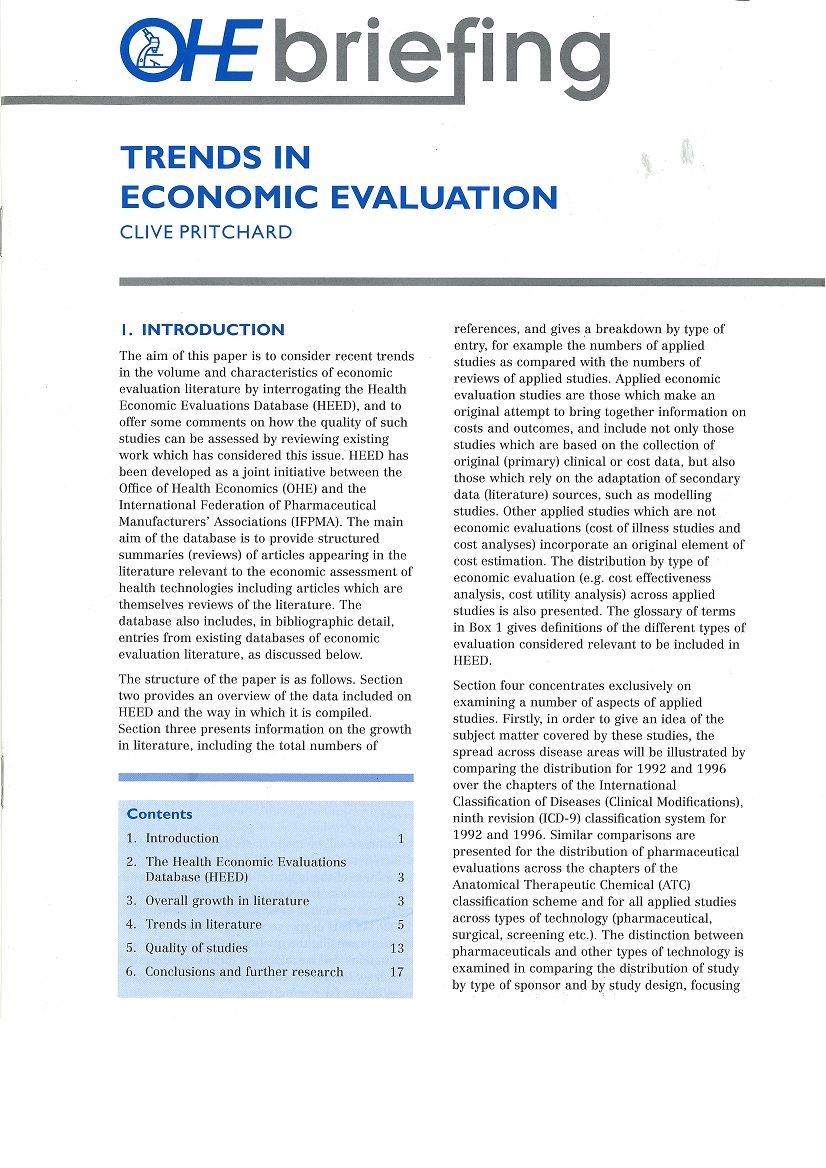Unlocking the Value of Combination Therapies

The aim of this paper is to consider recent trends in the volume and characteristics of economic evaluation literature by interrogating the Health Economic Evaluations Database (HEED), and to offer some comments on how the quality of such studies can be assessed by…
The aim of this paper is to consider recent trends in the volume and characteristics of economic evaluation literature by interrogating the Health Economic Evaluations Database (HEED), and to offer some comments on how the quality of such studies can be assessed by reviewing existing work which has considered this issue. HEED has been developed as a joint initiative between the Office of Health Economics (OHE) and the International Federation of Pharmaceutical Manufacturers’ Associations (IFPMA). The main aim of the database is to provide structured summaries (reviews) of articles appearing in the literature relevant to the economic assessment of health technologies including articles which are themselves reviews of the literature. The database also includes, in bibliographic detail, entries from existing databases of economic evaluation literature, as discussed below.
The structure of the paper is as follows. Section two provides an overview of the data included on HEED and the way in which it is compiled. Section three presents information on the growth in literature, including the total numbers of references, and gives a breakdown by type of entry, for example the numbers of applied studies as compared with the numbers of reviews of applied studies. Applied economic evaluation studies are those which make an original attempt to bring together information on costs and outcomes, and include not only those studies which are based on the collection of original (primary) clinical or cost data, but also those which rely on the adaptation of secondary data (literature) sources, such as modelling studies. Other applied studies which are not economic evaluations (cost of illness studies and cost analyses) incorporate an original element of cost estimation. The distribution by type of economic evaluation (e.g. cost effectiveness analysis, cost utility analysis) across applied studies is also presented. The glossary of terms in Box 1 gives definitions of the different types of evaluation considered relevant to be included in HEED.
Section four concentrates exclusively on examining a number of aspects of applied studies. Firstly, in order to give an idea of the subject matter covered by these studies, the spread across disease areas will be illustrated by comparing the distribution for 1992 and 1996 over the chapters of the International Classification of Diseases (Clinical Modifications), ninth revision (ICD-9) classification system for 1992 and 1996. Similar comparisons are presented for the distribution of pharmaceutical evaluations across the chapters of the Anatomical Therapeutic Chemical (ATC) classification scheme and for all applied studies across types of technology (pharmaceutical, surgical, screening etc.). The distinction between pharmaceuticals and other types of technology is examined in comparing the distribution of study by type of sponsor and by study design, focusing specifically on studies which can be classified as economic evaluations alongside randomized trials. Separate consideration is given to cost utility analyses to explore how utility measurement has been undertaken, while the final two sub-sections investigate the use of sensitivity analysis and discounting in all applied studies.
The topics covered in section four were selected on the basis either for comparison with the findings of previous studies charting trends in the economic evaluation literature or because it is a methodological issue of interest. For example. Mason and Drummond (1995) have described the distribution of entries in the Department of Health Register of Cost-Effectiveness Studies according to ICD-9 chapter while, in their economic evaluation bibliography, Elixhauser et al. (1993) discuss the types of technology assessed. Methodological aspects of the literature that have been addressed include the conduct of economic evaluations alongside clinical trials (Drummond and Davies, 1991), the quality of cost-utility analyses (Gerard, 1992) and the use of sensitivity analyses (Briggs and Sculpher, 1992). Although the paper does not attempt to provide an in-depth discussion of the quality of studies, the discussion should be of interest to readers of previous overviews of the economic evaluation literature, such as Warner and Mutton (1980) and Elixhauser et al. (1993).
Comments will be made in section live about the difficulties of making quality assessments and the usefulness of the typical checklist approach used by researchers when attempting to assess the quality of economic evaluations (e.g. Udvarhelyi, 1992). As part of this section, a number of studies assessing the quality of economic evaluations will be reviewed. Finally, section six will draw together some conclusions and suggest possibilities for further research.
Trends in Economic Evaluation
Pritchard, C.
(1998) Trends in Economic Evaluation. OHE Briefing. Available from https://www.ohe.org/publications/trends-economic-evaluation/